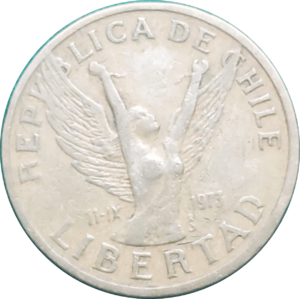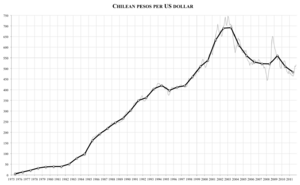Chilean peso facts for kids
Quick facts for kids Chilean peso |
|
|---|---|
| ISO 4217 Code | CLP |
| User(s) | Chile |
| Inflation | 4.4% |
| Source | 2024 ([1]) |
| Symbol | $ |
| Coins | 10, 50, 100, 500 |
| Banknotes | 1000, 2000, 5000, 10000, 20000 |
The peso is the money used in Chile. The peso we know today has been used since 1975. Before that, an older version was used from 1817 to 1960.
The symbol for the peso is a letter S with one or two lines through it, like $. This symbol is also used for other currencies, like the United States dollar. To avoid confusion, people sometimes write CLP$ or US$. The special code for the Chilean peso is CLP.
Until 1996, the peso was divided into 100 centavos. But now, payments are only made in whole pesos. In July 2024, about 940 Chilean pesos were equal to 1 US dollar. The current peso was introduced on September 29, 1975. It replaced the old Chilean escudo at a rate of 1 peso for every 1,000 escudos.
Contents
Chilean Peso Coins: What to Know
In 1975, Chile started using new coins. These included 1, 5, 10, and 50 centavos, plus 1 peso coins. Over time, due to rising prices (inflation), the centavo coins became less useful.
- Newer Coins: In 1976, 5 and 10 peso coins were added. Then came 50 and 100 peso coins in 1981. A special 500 peso coin, made of two different metals, was introduced in 2000.
- Coins Today: Currently, you'll find 10, 50, 100, and 500 peso coins. The 1 and 5 peso coins are very rare.
- Rounding Payments: Since November 2017, shops in Chile round cash payments. If the total ends in 1 to 5 pesos, it's rounded down. If it ends in 6 to 9 pesos, it's rounded up. This only affects cash payments, not electronic ones.
Special Coin Designs and Changes
After a period of military rule in Chile (1973–1990), the designs on the 5 and 10 peso coins changed.
- Old Design: These coins showed a winged female figure breaking chains. They also had the date of the 1973 change and the word "LIBERTAD" (meaning "liberty").
- New Design: After democracy returned, coins featured the portrait of Bernardo O'Higgins, a famous Chilean leader.
In 2001, a new 100-peso coin was released. It showed a Mapuche woman, honoring Chile's native people.
The Misspelled Coin
In 2010, people found a mistake on some 50 peso coins from 2008. The country name "CHILE" was misspelled as "CHIIE"! Even though they were worth about 9 US cents, these faulty coins became special items for collectors. The national mint decided not to recall them.
Chilean Peso Banknotes: What to Know
In 1976, Chile started using banknotes for 5, 10, 50, and 100 pesos. As prices went up, the country needed much higher value notes.
- Newer Notes: A 500-peso note came out in 1977, followed by 1000 pesos (1978), 5000 pesos (1981), 10,000 pesos (1989), 2000 pesos (1997), and 20,000 pesos (1998).
- Notes Today: The 5, 10, 50, 100, and 500-peso banknotes have been replaced by coins. So, only the 1000, 2000, 5000, 10,000, and 20,000 peso notes are used today.
- New Designs: Between 2009 and 2011, the higher value notes got new designs. The 1000-peso note was updated in May 2011.
Polymer Banknotes
Since 2004, some banknotes have been made from a special plastic material called polymer.
- The 2000-peso note switched to polymer in 2004.
- The 5000-peso note followed in 2009.
- The 1000-peso note became polymer in 2011.
This was the first time Chile changed its banknotes for reasons other than inflation. The 10,000 and 20,000 peso notes are still made of cotton paper.
All the new notes are 70 mm tall. Their length changes based on their value. The 1000-peso note is the shortest, and the 20,000-peso note is the longest. These new notes are also much harder to copy because of new security features. Companies from Australia and Sweden helped design and produce these new banknotes.
How the Peso's Value Changes Against the US Dollar
The value of the Chilean peso compared to the US dollar has changed a lot over the years.
| Date | Chilean pesos |
|---|---|
| June 2024 | 927 |
| May 2024 | 918 |
| April 2024 | 961 |
| March 2024 | 968 |
| February 2024 | 964 |
| January 2024 | 908 |
| 6-month average | 941 |
| 2023 | 840 |
| 2022 | 874 |
| 2021 | 760 |
| 2020 | 793 |
| 2019 | 703 |
| 2018 | 641 |
| 2017 | 650 |
| 2016 | 677 |
| 2015 | 655 |
| 2010 | 511 |
| 2005 | 560 |
| 2000 | 539 |
| 1995 | 397 |
| 1990 | 305 |
| 1985 | 161 |
From 1974 to 1979, the peso's value was allowed to change within certain limits. From 1979 to 1982, it was set at a fixed rate against the US dollar. In 1982, during an economic crisis, the peso's value was lowered. After that, different ways of setting its value were tried.
Since September 1999, the Chilean peso has been allowed to "float freely" against the US dollar. This means its value changes based on the market. However, Chile's Central Bank can step in if the peso loses too much value. They did this in 2001 and 2002 during times of economic trouble in other countries.
Recent Changes in Value
In 2022, the US dollar became much stronger against the Chilean peso. This happened for several reasons:
- The price of copper, a key export for Chile, dropped a lot.
- There was economic uncertainty and high inflation (prices rising quickly).
- People were unsure about the outcome of a big vote on a new constitution.
- Economic news from China was not good.
Because of these things, the dollar went above 1000 pesos for the first time ever, reaching over 1050 pesos per dollar. To help, the Central Bank of Chile stepped in. They used a large amount of money (up to US$25 billion) to try and stabilize the peso.
In 2023, the dollar's value against the peso went down quite a bit, to around 780 pesos per dollar. However, in July 2023, the Central Bank lowered its main interest rate. This made it easier to get loans but made savings accounts less profitable. This led to the dollar rising again to 860 pesos per dollar.
| Current CLP exchange rates | |
|---|---|
| From Google Finance: | AUD CAD CHF EUR GBP HKD JPY USD INR BRL ARS |
| From Yahoo! Finance: | AUD CAD CHF EUR GBP HKD JPY USD INR BRL ARS |
| From XE.com: | AUD CAD CHF EUR GBP HKD JPY USD INR BRL ARS |
| From OANDA: | AUD CAD CHF EUR GBP HKD JPY USD INR BRL ARS |
| From fxtop.com: | AUD CAD CHF EUR GBP HKD JPY USD INR BRL ARS |
See also
 In Spanish: Peso (moneda de Chile) para niños
In Spanish: Peso (moneda de Chile) para niños
- Economy of Chile
- Unidad de Fomento — a special unit used in Chile to adjust for inflation in contracts.
- Argentine peso
- Uruguayan peso





